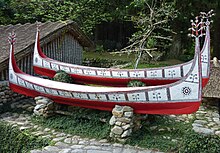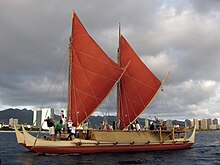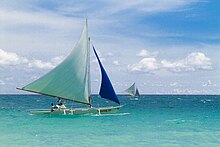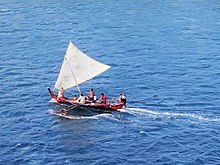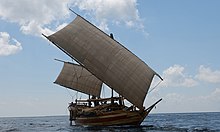

Tanja sail (Malay: layar tanjak) or tanja rig is a type of sail commonly used by the Austronesian people, particularly in Maritime Southeast Asia. It is also known as the tilted square sail, canted rectangular sail, rectangular balance lug, or balance lug sail in English.[1][2][3]: 102–103 [4]: 608 In historical sources, a tanja sail is sometimes incorrectly referred to as a lateen sail or simply square sail.[5]
Etymology
[edit]
Also called tanjaq, tanjak, tanja', tanjong, or tanjung sail. The Mandar people call it sombal tanjaq because when the wind blows the lower part of the sail (peloang) would "mattanjaq" (lit. "kick").[1][6] In colonial British records, it is sometimes written as "lyre tanjong", a misspelling of layar tanjong (layar means "sail" in Malay; layag in Philippine languages).[7][1]
Origin
[edit]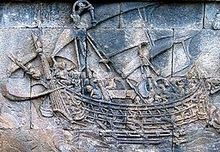
There are several different theories regarding the origin of tanja sail.
The sail might be a derivative of the older Austronesian triangular crab-claw sail. It developed from the fixed mast version of the crab-claw sail and is functionally identical, with the only difference being that the upper and bottom spars of the tanja sail do not converge into a point in the leading edge.[8][9]: 98–99
According to H. Warington Smyth, the Malay tanja sail is an adaptation and development of the primitive square sail, with boom at the head and the foot. The Malay tilted the sail forward, to bring the tack right to the deck, turning the sail into the most powerful of lifting sails on a wind.[10]
Characteristics
[edit]

Tanja sail can be distinguished by its canted/oblique design. The sail face is asymmetrical in shape and most of the area is elongated to the sides, rather than upward like those of lug sail. Tanja sails were rigged similarly to crab claw sails and also had spars on both the head and the foot of the sails; but they were square or rectangular with the spars not converging into a point.[8][9] They are generally mounted on one or two (rarely three) bipod or tripod masts, usually made from thick bamboo.[11][12][13] The masts have curved heads with grooves for attaching the halyards. The lower part of two of the bamboo poles of the mast assembly have holes that are aligned and slotted across a piece of timber, functioning as a hinge. The forward part of the mast assembly had a forelock. By unlocking it, the masts can be lowered across the ship.[11]
Despite the similarity of its appearance to western square rigs, the tanja is a fore-and-aft rig functioning similar to a lugsail. The sail was suspended from the upper spar ("yard"), while the lower spar functioned like a boom.[11] When set fore-and-aft, the spars extend forward of the mast by about a third. When running before the wind, they are set perpendicular to the hull, similar to a square rig.[14] The sail can be rotated around the mast (lessening the need for steering with the rudders) and tilted to move the center of pull forward or aft. The sail can even be tilted completely horizontally, lifting the bow above incoming waves. The sail is reefed by rolling it around the lower spar.[11]
In addition to the tanja sails, ships with the tanja rigs also have bowsprits set with a quadrilateral headsail, sometimes also canted as depicted in the Borobudur ships.[14] In the colonial era, these were replaced by triangular western-style jibs (often several in later periods), and the tanja sails themselves were slowly replaced with western rigs like gaff rigs.[11]
The 3rd century book "Strange Things of the South" (南州異物志) by Wan Chen (萬震) describes large ships which originates from K'un-lun (Southern country, either Java or Sumatra). The ships called K'un-lun po (or K'un-lun bo). He explains the ship's sail design as follows:
The four sails do not face directly forward, but are set obliquely, and so arranged that they can all be fixed in the same direction, to receive the wind and to spill it. Those sails which are behind the most windward one receiving the pressure of the wind, throw it from one to the other, so that they all profit from its force. If it is violent, (the sailors) diminish or augment the surface of the sails according to the conditions. This oblique rig, which permits the sails to receive from one another the breath of the wind, obviates the anxiety attendant upon having high masts. Thus these ships sail without avoiding strong winds and dashing waves, by the aid of which they can make great speed.
— Wan Chen, Nánzhōu Yìwùzhì (Strange Things of the South)[15]: 207 [16]: 262
Usage
[edit]Most Southeast Asian and Austronesian vessels used the tanja sail. This type of sail may have brought Austronesian sailors as far as West Africa sometime in the 1st millennium CE,[17]: 41 with its feasibility proved by an expedition carried out by a replica ship using such sail in 2003,[17]: 31–32 and there is probability these sailors reached the New World as early as 1420 CE.[18][19][better source needed] Some examples of vessels that use tanja sails include:
See also
[edit]References
[edit]- ^ a b c Hawkins, Clifford W. (1982). Praus of Indonesia. Nautical Books. p. 47.
- ^ Liebner, Horst (November 1992). "Remarks on the terminology of boatbuilding and seamanship in some languages of Southern Sulawesi". Indonesia Circle. School of Oriental & African Studies. Newsletter. 21 (59–60): 18–44. doi:10.1080/03062849208729790.
- ^ Hourani, George Fadlo (1951). Arab Seafaring in the Indian Ocean in Ancient and Early Medieval Times. New Jersey: Princeton University Press.
- ^ Needham, Joseph (1971). Science and Civilisation in China: Volume 4, Physics and Physical Technology, Part III: Civil Engineering and Nautics. Cambridge: Cambridge University Press.
- ^ Reid, Anthony (2000). Charting the Course of Early Modern Southeast Asia. Silkworm Books. ISBN 9747551063.
- ^ Haryadi, Rohmat (13 November 2017). "Padewakang the Spice Ship of Nusantara". Gatra. Retrieved 20 June 2018.
- ^ Folkard, H.C. (1863). The Sailing Boat: A Treatise on English and Foreign Boats. Longman, Green, Longman, and Roberts. pp. 216, 221, 222.
- ^ a b Campbell, I.C. (1995). "The Lateen Sail in World History". Journal of World History. 6 (1): 1–23. JSTOR 20078617.
- ^ a b Horridge, Adrian (April 1986). "The Evolution of Pacific Canoe Rigs". The Journal of Pacific History. 21 (2): 83–99. doi:10.1080/00223348608572530. JSTOR 25168892.
- ^ Smyth, H. Warington (May 16, 1902). "Boats and Boat Building in the Malay Peninsula". Journal of the Society of Arts. 50: 570–588 – via JSTOR.
- ^ a b c d e Pelras, Christian (1997). The Bugis. John Wiley & Sons. pp. 258–259. ISBN 9780631172314.
- ^ Burningham, Nick (2019). "Shipping of the Indian Ocean World". In Schottenhammer, Angela (ed.). Early global interconnectivity across the Indian Ocean world. Volume 2: Exchange of ideas, religions, and technologies. Palgrave Macmillan. pp. 141–202. ISBN 9783319978017.
- ^ Chaudhuri, K.N. (1985). Trade and Civilisation in the Indian Ocean: An Economic History from the Rise of Islam to 1750. Cambridge University Press. p. 152. ISBN 9780521285421.
- ^ a b Paine, Lincoln (2013). The Sea and Civilization: A Maritime History of the World. Knopf Doubleday Publishing Group. p. 286. ISBN 9780307962256.
- ^ Temple, Robert (2007). The Genius of China: 3000 Years of Science, Discovery Invention. London: Andre Deutsch.
- ^ Manguin, Pierre-Yves (1993). "Trading Ships of the South China Sea. Shipbuilding Techniques and Their Role in the History of the Development of Asian Trade Networks". Journal of the Economic and Social History of the Orient: 253–280.
- ^ a b Dick-Read, Robert (July 2006). "Indonesia and Africa: questioning the origins of some of Africa's most famous icons". The Journal for Transdisciplinary Research in Southern Africa. 2 (1): 23–45. doi:10.4102/td.v2i1.307.
- ^ Text from Fra Mauro map, 10-A13, original Italian: "Circa hi ani del Signor 1420 una naue ouer çoncho de india discorse per una trauersa per el mar de india a la uia de le isole de hi homeni e de le done de fuora dal cauo de diab e tra le isole uerde e le oscuritade a la uia de ponente e de garbin per 40 çornade, non trouando mai altro che aiere e aqua, e per suo arbitrio iscorse 2000 mia e declinata la fortuna i fece suo retorno in çorni 70 fina al sopradito cauo de diab. E acostandose la naue a le riue per suo bisogno, i marinari uedeno uno ouo de uno oselo nominato chrocho, el qual ouo era de la grandeça de una bota d'anfora." [1]
- ^ Carta IX, 1 April 1512. In Pato, Raymundo Antonio de Bulhão (1884). Cartas de Affonso de Albuquerque, Seguidas de Documentos que as Elucidam tomo I (pp. 29–65). Lisboa: Typographia da Academia Real das Sciencas. p. 64.
| |||||||||||||||||||||||||
| |||||||||||||||||||||||||
| |||||||||||||||||||||||||
| |||||||||||||||||||||||||
| |||||||||||||||||||||||||
| |||||||||||||||||||||||||
| |||||||||||||||||||||||||
including limited use*, outdated† | |||||||
| Rigs (jury rigging) |
| ||||||
| Sails (sailing rigs) |
| ||||||
| Spars |
| ||||||
| Rigging |
| ||||||
| Overviews | |||||||||||||||||
|---|---|---|---|---|---|---|---|---|---|---|---|---|---|---|---|---|---|
| Sailing rigs | |||||||||||||||||
| By sailing rigs | |||||||||||||||||
| Multihull vessels | |||||||||||||||||
| Naval and merchant sailing ships and other vessels (by origin date) |
| ||||||||||||||||
| Fishing vessels | |||||||||||||||||
| Recreational vessels | |||||||||||||||||
| Special terms | |||||||||||||||||
| Other types | |||||||||||||||||
| Related | |||||||||||||||||
Indonesian traditional vessels and sails | |||||||||||||||
|---|---|---|---|---|---|---|---|---|---|---|---|---|---|---|---|
| Type of sails and rigging | |||||||||||||||
| Naval & merchant vessels (by origin date) |
| ||||||||||||||
| Fishing vessels | |||||||||||||||
